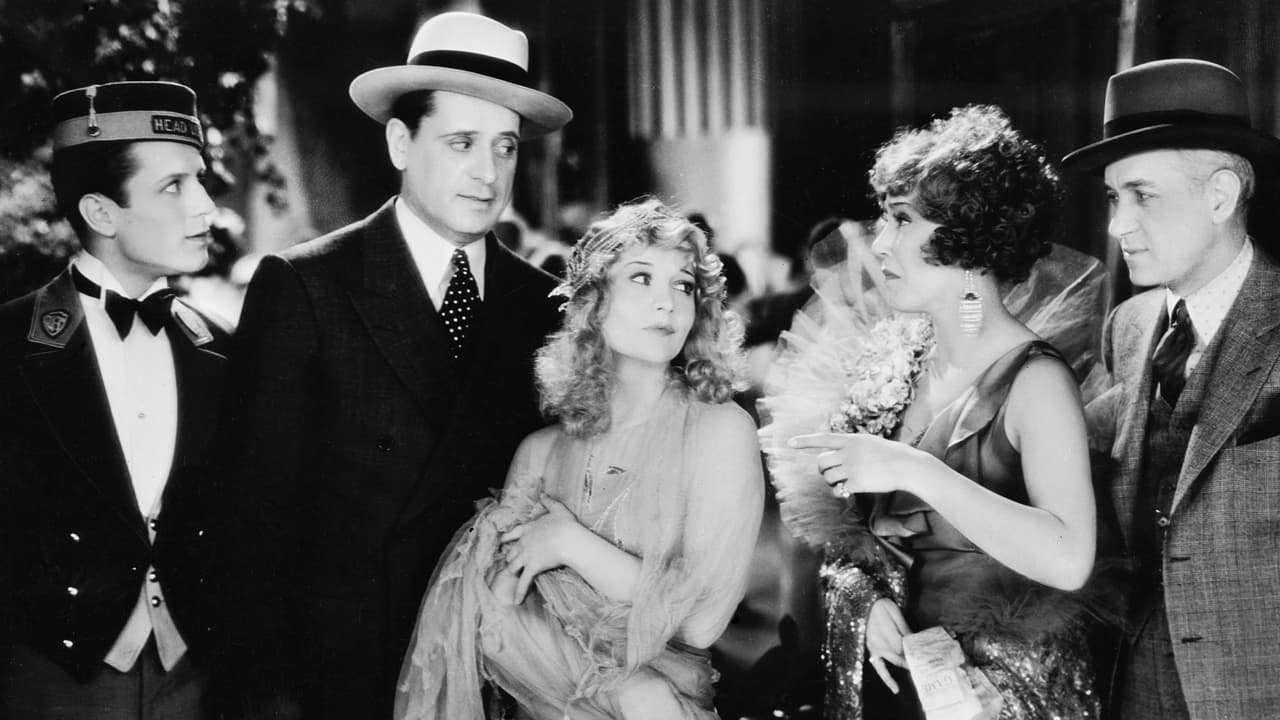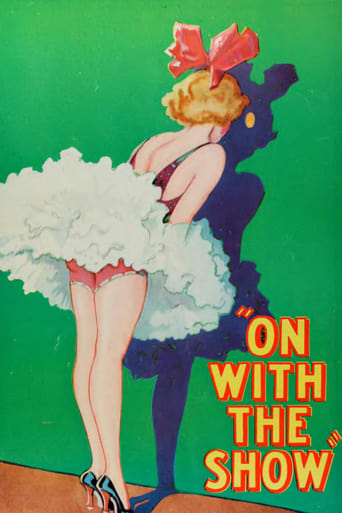

Early Warner Bros. musical, stagy, slow, and mostly of historical interest. The poor quality film available for viewing doesn't help. It's interesting to see how much the movie musical improved between this movie and, for instance, "42nd Street" (also a Warner Bros production) just a few years later. The dialog portions are very static, presumably due to the requirements of early sound pick up systems. However, the result is to bring the action to a halt. The overacting is almost unintentionally laughable. Betty Compson finally has a decent scene near the end of the movie. Arthur Lake is just plain irritating, and I couldn't even warm up to Joe E. Brown. Some of the singers seems to be recorded live, and others poorly dubbed. By far, the most interesting scenes are Ethel Waters singing "Am I Blue", and the quartet of black tap dancers who are unidentified.
... View MoreThis one will probably be of interest only to fans of the early talkies. Because it is made so early in the talking picture era, it suffers from dialogue overload, which results in an over-long run time of 103 minutes that could have easily shed 30 minutes without anyone objecting or even noticing. The main thing that harms this film is that it was originally shot completely in two-strip Technicolor, but only the black and white prints made for television remain. As a result you have lots of chorus girls parading around in elaborate gowns, pausing for the audience to get an eyeful, and then moving on. In black and white these scenes are just dull and stagnant, but if you've ever seen the same thing in the remaining color reels of "Gold Diggers of Broadway" from the same year, you realize how truly spectacular this must have looked to 1929 audiences. Also, Alan Crosland's sharp visual style includes lots of cross-cutting so that you don't have the claustrophobic static effect that you normally get from Vitaphoned films whose camera booths could not move an inch.It is a show within a show, the film being the story of one make-or-break night in the life of "The Phantom Sweetheart" and its cast, as it lumbers towards Broadway. You get to see "The Phantom Sweetheart" play out in its long-winded entirety, which actually contains the high-points of the film. These include two numbers by Ethel Waters as herself performing "Birmingham Bertha" and "Am I Blue" as well as the eccentric dancing and acrobatics of Joe E. Brown. Ms. Waters has no dialogue in the film, and for that matter her excellent numbers have absolutely nothing to do with the plot of "The Phantom Sweetheart", which is an inane tale of a young man who comes home from a long trip to marry his girl, but falls for a mysterious nymph of the woods and has to decide whether to go with this surreal and beckoning creature, or stay with the girl to whom he is betrothed. Harold (Arthur Lake), the double-minded young star of the Phantom Sweetheart, is as annoying and whiny on stage as he is backstage.Backstage, the center of attention is Kitty (Sally O'Neill), an usher with the show who is in love with the other usher and whose father has invested everything he has in the world with the show. Betty Compson, the most overworked actress of 1929, is the "phantom sweetheart" and star of the show who threatens not to go on if she isn't paid her back wages. This film is full of performers who are either the victims of the transition to sound or the product of failed Warner Brothers experiments with stage performers. Thus, you'll likely not recognize 80% of the cast. For example, Sally O'Neill had been making a good career in films in the late silent era. Unfortunately, in reality she was saddled with a heavy New Jersey accent that is compensated for in this film by making her overly-sweet. A little bit of cute sweetness would be a good thing, but since she is basically the female lead here, I was ready to shoot an arrow through her forehead at the film's half-way point just to put an end to her bubbly babble.So watch it for the wonderful Ethel Waters as herself, for Joe E. Brown and his well delivered smart comments and acrobatics, and for the infancy of the urban working-class banter that will become Warner Brothers stock and trade during the early 30's.
... View MoreON WITH THE SHOW (Warner Brothers, 1929), directed by Alan Crosland, is the studio's contribution to MGM's box office hit, THE Broadway MELODY. Unlike other backstage musicals from that era, this one consists of no dress rehearsals nor pre-show preparations. It skips all that in favor of what's presented on opening night at the Wallace Theater somewhere in New Jersey. The opening title card sums it up best, "For weeks, 'The Phantom Sweetheart' troupe has staggered through the rough tank towns toward distant Broadway It's pathway strewn with unpaid bills. Tonight would tell the tale, Broadway or Bust." And Broadway or Bust it is. In fact, an odd mixture of two stories for the price of one. The first being the behind the scenes plot development revolving around the theatrical troupe and staff. Instead of the usual unrelated musical numbers most commonly found in Hollywood back-stagers, the second story titled "The Phantom Sweetheart," is set to song and dance on a Southern plantation where a young man (Arthur Lake) falls in love with a veiled goddess (Betty Compson) prior to his wedding day. Not seen in its entirety, the stage production is interrupted with inter-cuts of the backstage story.In spite of Lake and Compson heading the cast, their scenes, along with others, are secondary. There are no characters who actually dominate the story from start to finish, but an assortment of those coming in and out whenever their scenes allow. The center of attention really belongs to the least likely pair of Jimmy (William Bakewell), the head usher, and his girlfriend, Kitty (Sally O'Neil), a coat room girl, whom Jimmy feels has the "stuff" to make it on Broadway After the rise of the curtain where the actors perform to a full house, situations occur, all involving money. Jerry (Sam Hardy), the producer, owes Sam Bloom (Purnell B. Pratt) unpaid bills and keeps him from taking back his scenery or taking what's owed him from the box office cash receipts; Willie Durant (Wheelar Oakman), the show's backer, refuses to guarantee capital income and later forces himself on Kitty; Harold Astor (Lake), the juvenile leading man in need of cash to give to his mother, constantly bickering about scene stealing with fellow comedian Joe Beaton (Joe E. Brown); and leading lady Nita French (Compson), refusing to continue her performance unless she receives the $400 due her. The very moment of her strike, the box office gets held up by a mysterious figure holding a gun. All this, and opening night, too, but the show must go on, Broadway or bust.With score composed by Harry Akst and Grant Clarke, the musical program is as follows: "Welcome Home" (sung by Henry Fink); "Let Me Have My Dreams" (sung by Betty Compson); "Am I Blue?" (sung by Ethel Waters); "Lift the Tulips in Your Two Lips" (sung by Fink and Josephine Houston, danced by the Four Covans); "Let Me Have My Dreams" (reprise by Compson); specialty dance solo number (Joe E. Brown); "In The Land of Let's Pretend" (sung by chorus); "Don't It Mean a Thing to You" (sung by Josephine Houston and Arthur Lake); "Let Me Have My Dreams" (sung by Sally O'Neil); "Birmingham Bertha" (sung by Ethel Waters); "Wedding Day" (sung by Fink, Lake and Houston); and Finale (entire cast).Other members of the cast consist of Louise Fazenda as Sarah Fogerty, an eccentric comedienne who supplies offstage laughter; Thomas Jefferson (not the third U.S.President) as "Dad", the stage doorman; Lee Moran and Harry Gribbon as stage hands, Pete and Ike, along with specialty acts by the Fairbanks Twins and an assortment of black entertainers highlighted by a Ethel Waters, in her movie debut, taking center stage with her fine rendition of the film's most notable song, "Am I Blue?" Her solo effort, along with "Birmingham Bertha" opposite Charlie Bubbles, both unrelated to the theatrical story, are highlights, along with a lively but unmemorable score to make up for its dull stretches at the midway point. The staging by Larry Ceballos is adequate, not spectacular, yet steps towards the right direction compared to 1929 stage musicals consisting of cart wheel dancing and acrobatics.Crosland, who made history directing THE JAZZ SINGER (1927), the "first talkie," improves with techniques revolving around camera movement with angles taken from different parts of the stage, above and beyond spiral staircases as chorus girls rush down to meet their curtain call, and silhouette image of musical conductor in orchestra pit waving his stick in front of the rising curtain or stage performance. What's lacking is further use of close-ups of principal players and dancers, something that would be common place in future musicals to come. It's also fun going back in time watching antiques like this and listening to catch phrases of the day of "Go sit on a tack," or corny dialog recited by Sam Hardy, "There are only a few of you sweet kids left," or "Go out and give them everything you got." For 1929, ON WITH THE SHOW made cinema history for being the first musical filmed entirely in color. Current prints that have circulated either in revival theaters of the 1970s and 80s, later on cable television (TNT in February 1991 as part of a tribute to Black History Month) and on Turner Classic Movies, are currently in black and white. To date, color prints are presumed lost. Fortunately the movie survives, considering how many early talkies have been lost due to neglect or decay.Its length of 103 minutes might be a bit long, but I cannot help but feel its initial theatrical showing was a bit longer considering a slight interruption of the underscoring after the opening cast credits. And now, on with the show. (***)
... View MoreDesperate for Broadway, the traveling troupe of The Phantom Sweetheart must always go ON WITH THE SHOW!Here is another very early talkie musical, full of excitement for the new medium, but bloated by too much talk, unexciting songs sung by the chorus with mostly unintelligible lyrics and an overlong running time. The plot deals with the usual frustrations & jealousies that most backstage musicals seem to find requisite.The cast includes William Bakewell as the head usher eager to get his sweetheart, box-office girl Sally O'Neill, her chance at the Great White Way. Betty Compson plays the temperamental star and Arthur Lake the whiny young male lead. Louise Fazenda is the company's eccentric comedienne, who is given little to do but laugh at inappropriate moments.The film does have some compensations. Rubber faced Joe E. Brown is cast as the company's brash comic and, as always, he is funny simply to look at. Best of all, the incomparable Ethel Waters is brought in to sing a couple of songs, including 'Am I Blue?' Miss Waters has no connection with the rest of the story whatsoever, but just enjoying her for a few minutes is pure pleasure.
... View More